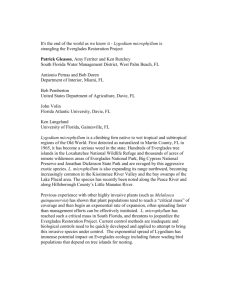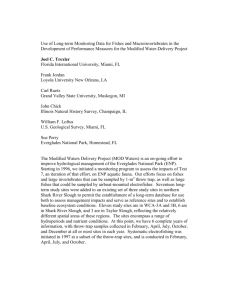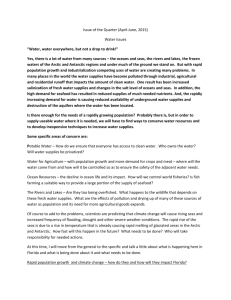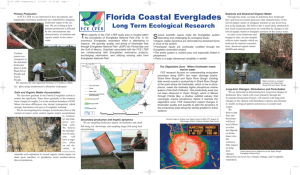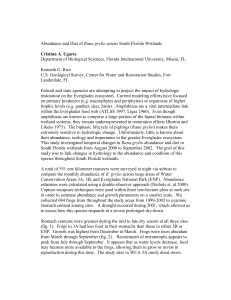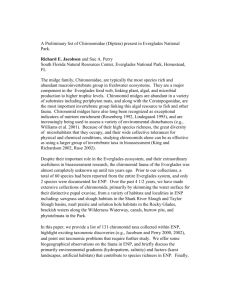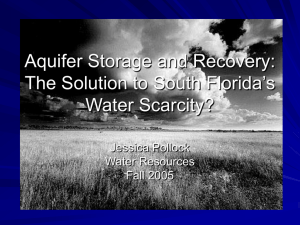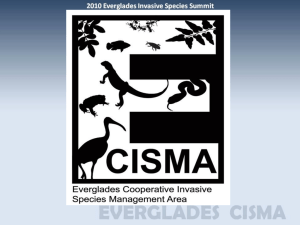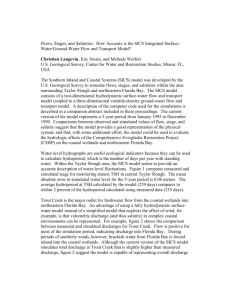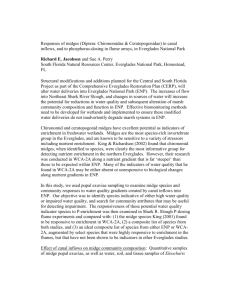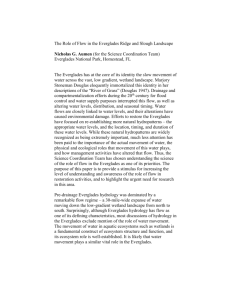Applications of a Numerical Model for Simulation of Flow and
advertisement
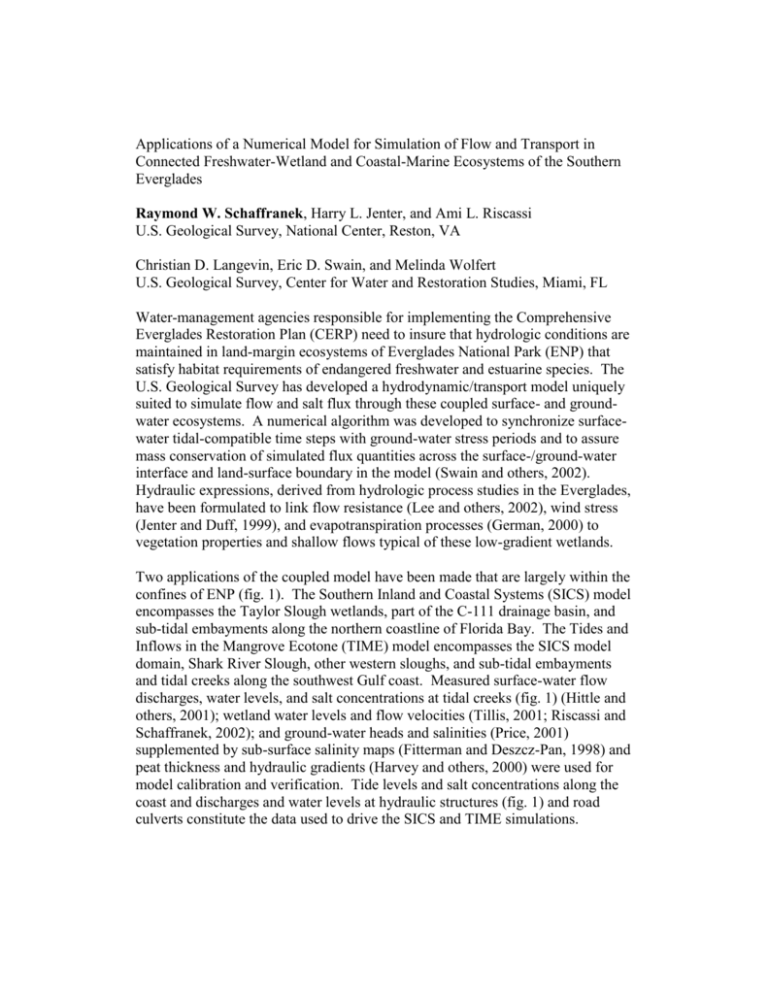
Applications of a Numerical Model for Simulation of Flow and Transport in Connected Freshwater-Wetland and Coastal-Marine Ecosystems of the Southern Everglades Raymond W. Schaffranek, Harry L. Jenter, and Ami L. Riscassi U.S. Geological Survey, National Center, Reston, VA Christian D. Langevin, Eric D. Swain, and Melinda Wolfert U.S. Geological Survey, Center for Water and Restoration Studies, Miami, FL Water-management agencies responsible for implementing the Comprehensive Everglades Restoration Plan (CERP) need to insure that hydrologic conditions are maintained in land-margin ecosystems of Everglades National Park (ENP) that satisfy habitat requirements of endangered freshwater and estuarine species. The U.S. Geological Survey has developed a hydrodynamic/transport model uniquely suited to simulate flow and salt flux through these coupled surface- and groundwater ecosystems. A numerical algorithm was developed to synchronize surfacewater tidal-compatible time steps with ground-water stress periods and to assure mass conservation of simulated flux quantities across the surface-/ground-water interface and land-surface boundary in the model (Swain and others, 2002). Hydraulic expressions, derived from hydrologic process studies in the Everglades, have been formulated to link flow resistance (Lee and others, 2002), wind stress (Jenter and Duff, 1999), and evapotranspiration processes (German, 2000) to vegetation properties and shallow flows typical of these low-gradient wetlands. Two applications of the coupled model have been made that are largely within the confines of ENP (fig. 1). The Southern Inland and Coastal Systems (SICS) model encompasses the Taylor Slough wetlands, part of the C-111 drainage basin, and sub-tidal embayments along the northern coastline of Florida Bay. The Tides and Inflows in the Mangrove Ecotone (TIME) model encompasses the SICS model domain, Shark River Slough, other western sloughs, and sub-tidal embayments and tidal creeks along the southwest Gulf coast. Measured surface-water flow discharges, water levels, and salt concentrations at tidal creeks (fig. 1) (Hittle and others, 2001); wetland water levels and flow velocities (Tillis, 2001; Riscassi and Schaffranek, 2002); and ground-water heads and salinities (Price, 2001) supplemented by sub-surface salinity maps (Fitterman and Deszcz-Pan, 1998) and peat thickness and hydraulic gradients (Harvey and others, 2000) were used for model calibration and verification. Tide levels and salt concentrations along the coast and discharges and water levels at hydraulic structures (fig. 1) and road culverts constitute the data used to drive the SICS and TIME simulations. Flow exchanges between the surface- and ground-water systems simulated by the SICS model are presented in figure 2 to demonstrate its capability and illustrate typical model output. Positive exchanges, expressed as averages in cm/day for the 5-year simulation, indicate areas of recharge to the aquifer and negative values indicate areas of discharge to the wetlands. Similar output is available that identifies salt fluxes between the surface- and ground-water systems. Model output such as this is needed to fully evaluate the potential impact of restoration decisions for the greater Everglades on coastal land-margin ecosystems of ENP. Fitterman, D.V., and Deszcz-Pan, M., 1998, Helicopter EM mapping of saltwater intrusion in ENP, Florida: Exploration Geophysics, v. 29, p. 240-243. German, E.R., 2000, Regional evaluation of evapotranspiration in the Everglades, USGS WRI 00-4217, 48 p. Harvey, J.W., Jackson, J.M., Mooney, R.H., and Choi, J., 2000, Interaction between ground water and surface water in Taylor Slough and vicinity, ENP, South Florida: Study methods and appendixes, USGS OFR 00-483, 67 p. Hittle, C., Patino, E., and Zucker, M., 2001, Freshwater flow from estuarine creeks into northeastern Florida Bay. USGS WRI 01-4164, 37 p. Jenter, H.L., and Duff, M.P., 1999, Locally-forced wind effects on waters with emergent vegetation. Third International Symposium on Ecohydraulics, 9 p. Langevin, C.D., Swain, E.D., and Wolfert, M.A., 2002, Numerical simulation of integrated surface-water/groundwater flow and solute transport in the southern Everglades, Florida. Second Federal Interagency Hydrologic Modeling Conference, 12 p. Lee, J.K., Roig, L.C., Jenter, H.L. and Visser, H.M., 2002, Vertically averaged flow resistance in free surface flow through emergent vegetation at low Reynolds numbers. Submitted to Ecological Engineering. Price, R.M., 2001. Geochemical determinations of groundwater flow in ENP. Ph.D. Dissertation, University of Miami, Coral Gables, FL, 235 p. Riscassi, A.L., and Schaffranek, R.W., 2002, Flow velocity, water temperature, and conductivity in Shark River Slough, Everglades National Park, Florida: July 1999–August 2001. USGS OFR 02-159, 32 p. Schaffranek, R.W., Jenter, H.L., and Riscassi, A.L., 2002, Overview of the “Tides and Inflows in the Mangroves of the Everglades” (TIME) project of the U.S. Geological Survey’s South Florida Ecosystem Program. Second Federal Interagency Hydrologic Modeling Conference, 12 p. Swain, E., Langevin, C., and Wolfert, M., 2002, Cooperative linkage of numerical models for coastal wetlands planning". AWRA Spring Specialty Conference, May 13-15, 2002, pp. 375-380. Tillis, G.M., 2001, Measuring Taylor Slough boundaries and internal flows, Everglades National Park, Florida. USGS OFR 01-225, 16 p. Figure 1. South Florida satellite image showing SICS and TIME model domains. Figure 2. SICS model output showing surface-/ground-water exchange. Schaffranek, Raymond W., U.S. Geological Survey, National Center MS 430, Reston, VA 20192, (703) 648-5891, FAX: (703) 648-5484, rws@usgs.gov
